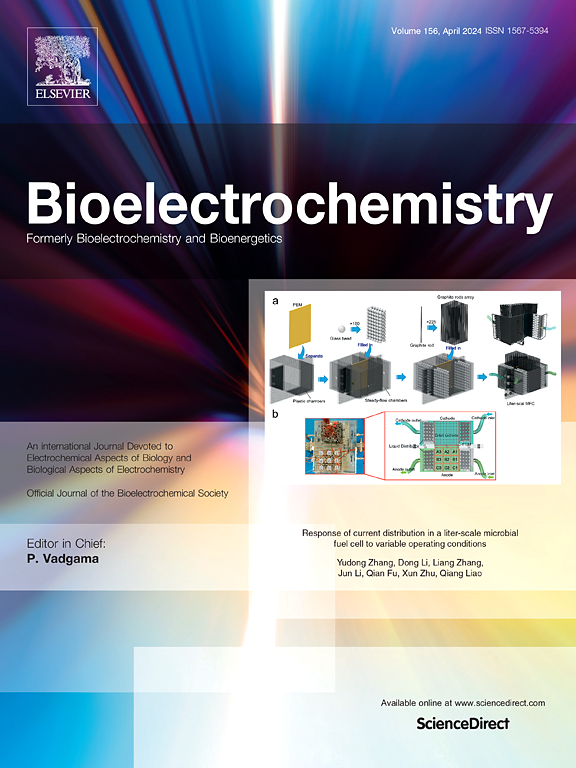利用AuNPs-Ti3C2Tx和ARGET ATRP反应作为信号放大策略的电化学生物传感器超灵敏检测HER2蛋白
IF 4.8
2区 化学
Q1 BIOCHEMISTRY & MOLECULAR BIOLOGY
引用次数: 0
摘要
人表皮生长因子受体2 (HER2)状态是评价乳腺癌患者预后的重要因素。因此,开发一种简便、灵敏的检测her2阳性乳腺癌的方法显得尤为重要。本研究以金纳米颗粒和二维碳化物(AuNPs-Ti3C2Tx)为导电底物,组装了一种用于检测her2特异性蛋白的超灵敏电化学生物传感器。制备的AuNPs-Ti3C2Tx不仅具有良好的导电性和较强的电化学信号输出,而且为AuS键组装适配体提供了大量的活性位点。此外,该抗体修饰的功能化氧化石墨烯(GO)作为载体平台,为在最佳条件下高灵敏度检测痕量靶标提供了额外的促进。随后,利用AuNPs-Ti3C2Tx的信号放大效应和功能化氧化石墨烯结合电子转移活化再生催化剂原子转移自由基聚合(ARGET ATRP)检测HER2蛋白。在1 ~ 105 ng·mL−1范围内,HER2浓度与信号强度呈良好的线性关系,检测限为0.19 pg·mL−1。而且该方法具有良好的选择性和稳定性,在正常人血清的复杂环境中仍能保持良好的检测性能和较强的抗干扰能力,有望在临床应用中得到应用。本文章由计算机程序翻译,如有差异,请以英文原文为准。

An electrochemical biosensor using AuNPs-Ti3C2Tx and ARGET ATRP reactions as signal amplification strategies for ultra-sensitive detection of HER2 protein
Human epidermal growth factor receptor 2 (HER2) status is an important factor in evaluating the prognosis of breast cancer patients. Therefore, it is particularly important to develop a simple and sensitive method for the detection of HER2-positive breast cancer. Here, an ultra-sensitive electrochemical biosensor for detecting HER2-specific proteins was assembled using gold nanoparticles and Two-dimensional carbides (AuNPs-Ti3C2Tx) as a conducting substrate. The prepared AuNPs-Ti3C2Tx not only has good electrical conductivity and strong electrochemical signal output, but also provides a large number of active sites for the Au![]() S bonds assembly aptamer. In addition, the antibodies-modified functionalized graphene oxide (GO) as a carrier platform, which provides an additional boost for the detection of trace targets with high sensitivity under optimal conditions. Afterwards,HER2 protein was detected by signal amplification effect of AuNPs-Ti3C2Tx and functionalized GO combined with Electron transfer activated regeneration catalyst atomic transfer radical polymerization (ARGET ATRP). In the range of 1 to 105 ng·mL−1, there was a good linear relationship between the HER2 concentration and the signal intensity, with a limit of detection of 0.19 pg·mL−1. Moreover, this method has good selectivity and stability, and then still maintains good detection performance and strong anti-interference ability in the complex environment of normal human serum, which is expected to be applied in clinical application.
S bonds assembly aptamer. In addition, the antibodies-modified functionalized graphene oxide (GO) as a carrier platform, which provides an additional boost for the detection of trace targets with high sensitivity under optimal conditions. Afterwards,HER2 protein was detected by signal amplification effect of AuNPs-Ti3C2Tx and functionalized GO combined with Electron transfer activated regeneration catalyst atomic transfer radical polymerization (ARGET ATRP). In the range of 1 to 105 ng·mL−1, there was a good linear relationship between the HER2 concentration and the signal intensity, with a limit of detection of 0.19 pg·mL−1. Moreover, this method has good selectivity and stability, and then still maintains good detection performance and strong anti-interference ability in the complex environment of normal human serum, which is expected to be applied in clinical application.
求助全文
通过发布文献求助,成功后即可免费获取论文全文。
去求助
来源期刊

Bioelectrochemistry
生物-电化学
CiteScore
9.10
自引率
6.00%
发文量
238
审稿时长
38 days
期刊介绍:
An International Journal Devoted to Electrochemical Aspects of Biology and Biological Aspects of Electrochemistry
Bioelectrochemistry is an international journal devoted to electrochemical principles in biology and biological aspects of electrochemistry. It publishes experimental and theoretical papers dealing with the electrochemical aspects of:
• Electrified interfaces (electric double layers, adsorption, electron transfer, protein electrochemistry, basic principles of biosensors, biosensor interfaces and bio-nanosensor design and construction.
• Electric and magnetic field effects (field-dependent processes, field interactions with molecules, intramolecular field effects, sensory systems for electric and magnetic fields, molecular and cellular mechanisms)
• Bioenergetics and signal transduction (energy conversion, photosynthetic and visual membranes)
• Biomembranes and model membranes (thermodynamics and mechanics, membrane transport, electroporation, fusion and insertion)
• Electrochemical applications in medicine and biotechnology (drug delivery and gene transfer to cells and tissues, iontophoresis, skin electroporation, injury and repair).
• Organization and use of arrays in-vitro and in-vivo, including as part of feedback control.
• Electrochemical interrogation of biofilms as generated by microorganisms and tissue reaction associated with medical implants.
 求助内容:
求助内容: 应助结果提醒方式:
应助结果提醒方式:


